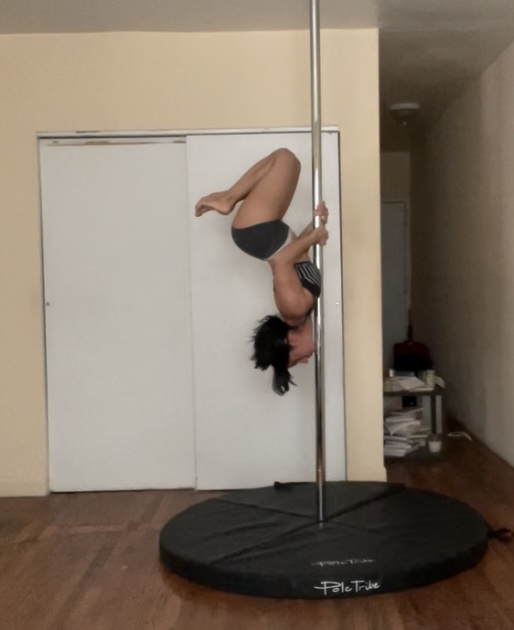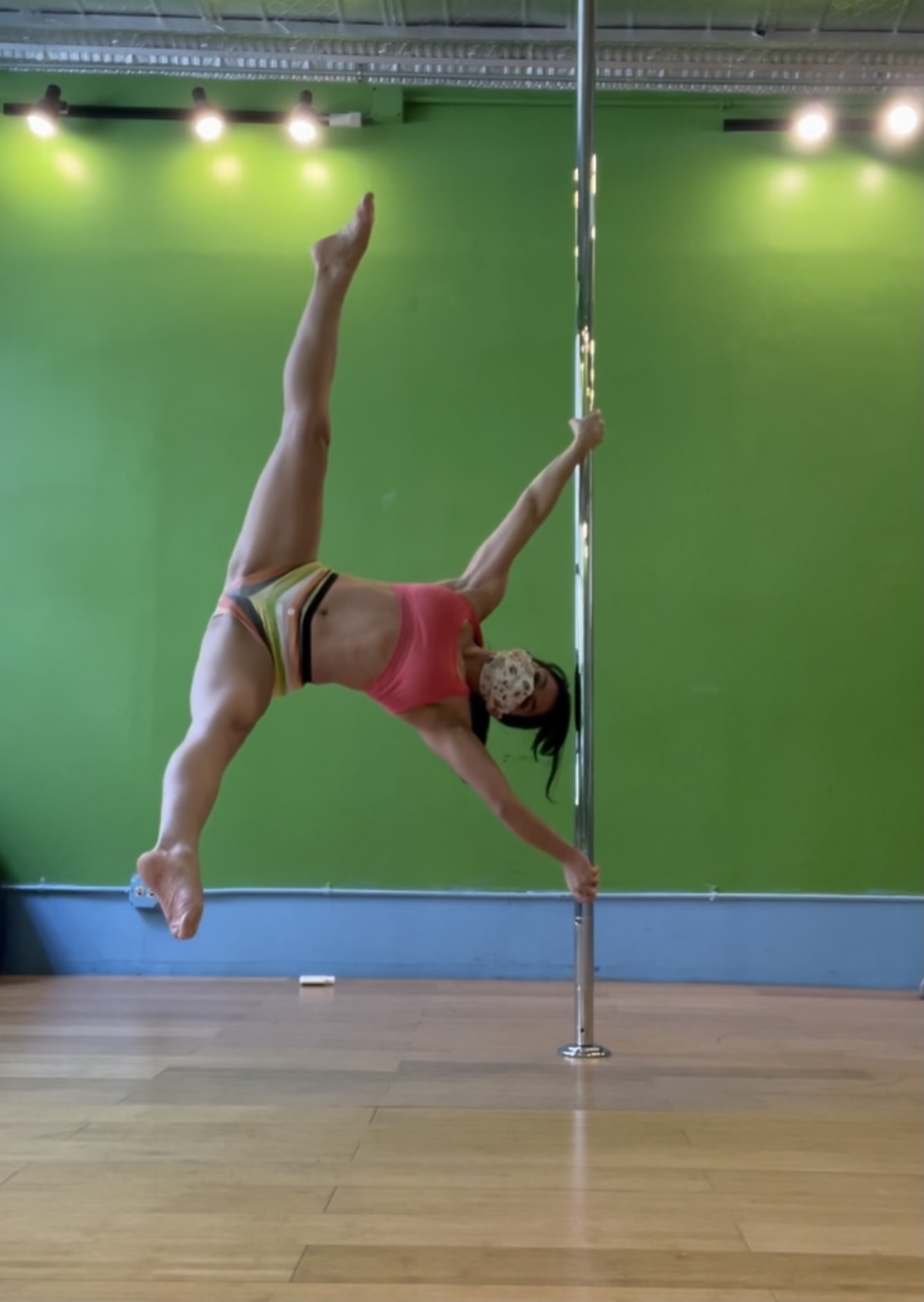In 2017, pole dancing was formally recognised by the Global Association of International Sports Federation (GAISF) as a sport. So why isn’t it taken more seriously by the wider sporting community? One fan, Kristin Russo, explains why athletes like her deserve more credit.
From outside the room of the studio, I could hear chatter, music and most riveting of all, hoots and grunts. As someone opened the door to make their way to the bathroom, I got a glimpse into the pole fitness room.A teacher was holding someone by the hips as they whelped their way into a pretzel position; another woman looked like she was walking on air – spinning at least 10ft off the ground; someone else had contorted their body into a terrifyingly deep backbend.
Pole is a visually captivating sport, and as my teacher and multi-medal international pole sports champion Ashley Fox puts it: “Pole doesn’t discriminate. Everyone has to start at the beginning.”
You may also like
Black women keep winning sporting medals – so why aren’t more Black women into fitness?
There is no better way to understand that than trying it for yourself. When I peeked into that room for the first time over three years ago, I had no idea of the journey, the bruises and the challenges that lay ahead of me.
As an athlete and qualified fitness instructor who had tried many things, it was obvious to me at that moment that the people working those poles possessed skills that I simply didn’t have. I knew, however, that I needed to try to hone them.
Bruises and ‘poll kisses’: learning the ropes of pole fitness
Pole requires a combination of strength, flexibility, coordination and balance. It’s a practice usually performed on metal poles, with people generally wearing as little as possible to execute tricks and poses safely.
When you tell someone that you do pole, their minds immediately wander to late night clubs where topless dancers spin and perform amazing tricks to titillate and entertain. Pole fitness, however, requires you to wear little in order to execute moves and tricks rather than to appear sexy.
Having skin-to-pole contact is a unique experience. Depending on the trick you’re doing and the time of month, you might be shrieking in discomfort or flying strong. This is just one of several reasons that pole should be taken seriously as a sport. The uncomfortable pole burn is colloquially known in the pole community as “pole kisses”. These are bruises that the pole not-so-affectionately leaves behind after you’ve clocked up the hours learning new tricks and exposing your skin and parts of your body to the metal (and in some cases, the floor).
Your mates might wonder if you’ve been in a brawl but there’s no need to call the authorities: bruising is all part of the pole experience. If you think that after a few months, you’ll grow out of developing huge patches of blue on your thighs and upper arms, think again: the more you learn new poses and tricks, the more bruises you’ll develop. They’re a consistent token of the adherence required to improve.

Why pole should be taken seriously as a sport
The first time that I tried to climb the pole, it was like getting a bucket of ice thrown in my face. “How could this be so difficult?” I asked myself. The other people in the class who had been practising for a while made it look as natural as walking. In our everyday lives, we don’t scale vertical, metal cylinders!
When we’re kids, it’s much easier to just jump on a tree, for example, and begin climbing. However, once learnt adult behaviour sets in, the natural ability to just go for it fades.
Saying that, I’ve found that stripping down to shorts and a sports bra (perhaps the first hurdle of pole) and then going through the awkward, painful experience of trying to even get on the pole has one overwhelming mental benefit: it either inspires your will to get better at it or stops you from ever trying again. I have seen both scenarios play out in the studio and there have definitely been times when I’ve doubted that I’ve improved. Despite that, I’ve shown up and tried. Mindset is a tremendous factor in pole.
You may also like
3 stretches to strengthen weak wrists at the start of your workouts
Pole fitness is hard. Watching someone else do it may make it appear effortless to the inexperienced eye, but you’ve got to point your toes, keep the pole at a specific point between your knees, keep your shoulders down, maintain a calm facial expression, gain height while you climb. Everything requires conscious effort.
Nailing those fundamentals is important because it helps you to know what to expect further down the line. Climbing may become second nature, but micro-bends in the knees, pointed toes and embarrassing faces need to continuously be addressed at any level of trick.
Pole fitness isn’t just about climbing – you’ve got to learn to spin too
More experienced pole athletes appear to be incredibly graceful as they harness both momentum and control in order to do visually appealing, head-turning spins around the pole. Done well, they make you think: “Oh, I can do that.”
When I first started spins, it was glaringly obvious that controlled use of momentum was a weakness for me, and of all the things pole encompasses, three years later, it is still the weakest part of my game. Many pole dancers admit to having stronger and weaker skills in the sport – and I think that’s quite unique. Because pole is such a multifaceted activity, it requires a host of skills and talents. For me, my strong suit is (aptly) strength. For others, it is flexibility, dance or power.
You’ve got to spend an equal amount of time honing all of the skills, as well as mastering the whole aerial aspect. There’s a reason that we learn how to climb up the pole and that’s because that’s where many tricks happen.If opening up your split on the floor wasn’t hard enough, pole invites you to try doing them up in the air.
Since pole encompasses a range of skills, it’s had an overwhelmingly positive impact on my fitness level. My strength is far more integrated than it was prior to taking part. My back, the stabilisers around my shoulders and my core muscles are all much stronger.I have had to greatly improve my active flexibility in order to keep my joints safe and to aim for the fullest expression of the shapes.
Strippers are part of the pole community – and that shouldn’t be a bad thing
Knowing what I do about pole, it seems wild to think that it’s still more associated with stripping than elite sport.
Any pole dancer will tell you that they are met with stripper jokes almost as soon as they disclose their hobby. Of course, strippers doing pole tricks aren’t engaging in any less of an activity. The ‘rainbow marchenko’, ‘iron-x’ and ‘no-hands jade’ are pole tricks that require practise and hard work – whether you are at a training studio, a gentlemen’s club or on a travel pole with palm trees behind you. The trick is the trick, and anyone performing it had to put in work to get it looking decent on the pole.
The strength and control required to perform floor tricks with and around the pole and to look sexy doing it is also no easy feat. Ever tried to do a ‘fish flop’ with platform heels on? Remaining controlled while making a beautiful, solid arch, pointing your toes and keeping a naturally enticing pout on your lips while doing this floor trick should be an Olympic category of its own.
We should be in awe of the strippers out there who make it look easy. They’re as much a part of the pole community as the rest of us.

The pole community is one of the most supportive there is
Of all the sports I’ve tried, pole has perhaps the most obviously supportive community. I’ve no doubt that that’s because of how challenging it is. Fellow practitioners support each other because they understand what it takes to – literally – get up there.
The hoots, hollers and grunts I heard from outside the door that first day ring in my ears at every class and every show. The audible effort is heard at studios around the world, in different levels of intensity and different styles of pole dance.
The best thing is, pole can be practised at any age and at any size, and should be regarded as serious a sport as any. It is well worth the bruises.
Get stronger from home with the intermediate strength training plan from the Strong Women Training Club – and then take that strength to your first pole class!
Images: author’s own.
Source: Read Full Article
